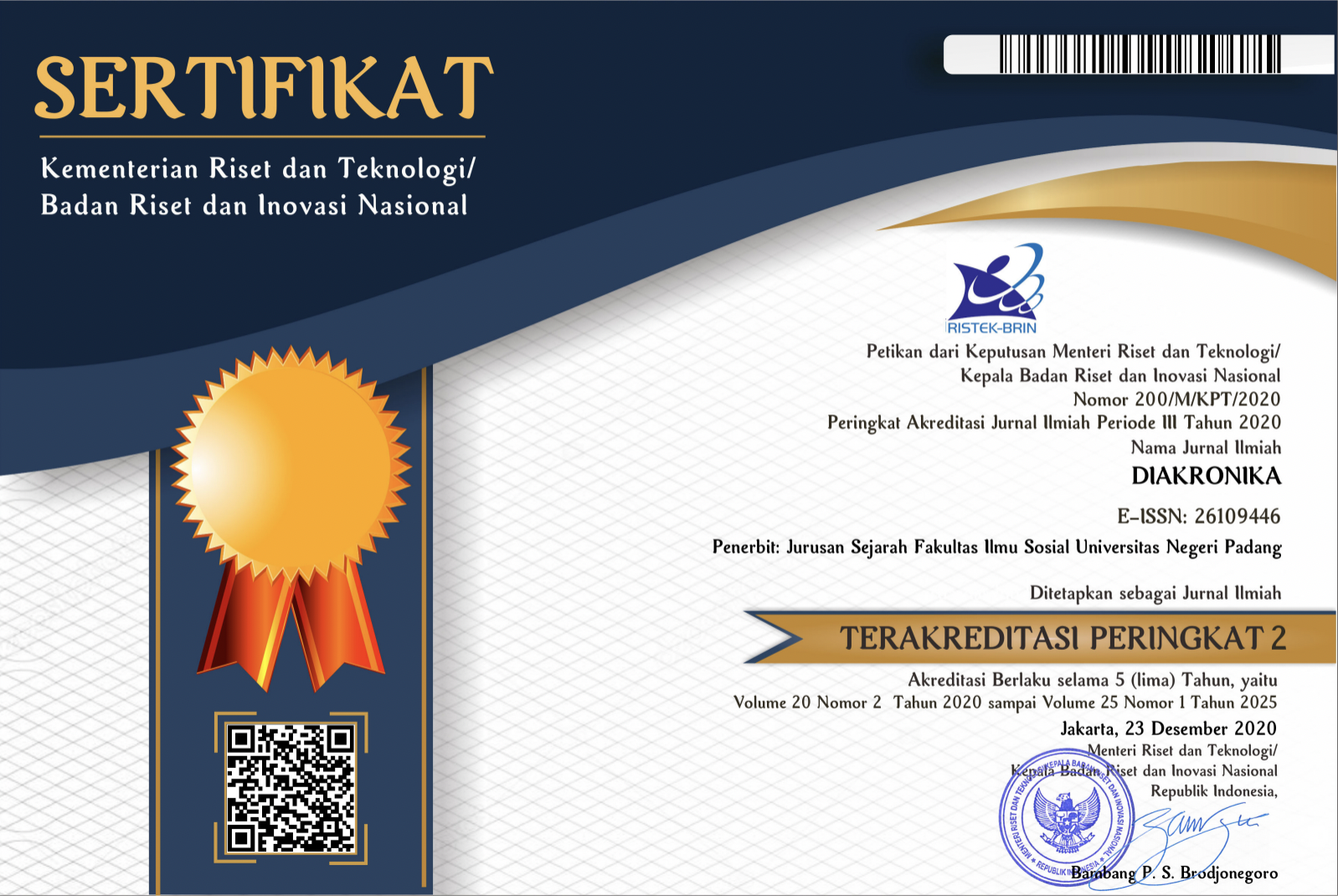Model Pembelajaran Value Clarification Technique (VCT) dalam Meningkatkan Kesadaran Sejarah Peserta Didik
Abstract
Historical awareness is a demand that needs to be achieved in history learning in the 4.0 era by implementing paradigma mereka belajar and the 2013 curriculum. The low historical awareness of the younger generation in the 4.0 era can be seen from the implementation of learning history in school. This is in line with the results of the questionnaire in three schools which showed the low awareness of the history of students, as follows; 59.42% for SMAN 4 Jember, 50.33% for SMAN 1 Tanggul and 58.66% for SMAN 2 Tanggul. This study aims to determine the effectiveness of the implementation of the Value Clarification Technique (VCT) model in increasing students' historical awareness. This type of research uses qualitative experimental research. The sample of this study was 98 students from class XI of SMAN 1 Tanggul, SMAN 2 Tanggul, and SMAN 4 Jember. Data collection techniques using a questionnaire. The results of this study indicate an increase in students' historical awareness which can be seen from the four historical awareness indicators, as follows; (1) 74.36%; (2) 86.40%; (3) 73.51% and (4) 72.39%. Based on this research, the researcher suggests educators to create a history learning environment that provides freedom to express themselves, respect each other, be responsible and utilize technology by paying attention to the historical awareness of students and being innovative in choosing the learning model to be implemented.
Downloads
References
Ahmad, et al, (2020). Academic Staff and Industry Revolution 4.0: Knowledge , Innovation and Learning Factor. Journal of Education and E-Learning Research 7(2):190–94. doi: 10.20448/journal.509.2020.72.190.194.
Aisiah, Suhartono, and Sumarno. (2016). The Measurement Model of Historical Awareness. Research and Evaluation in Education 2(2):108–21.
Aman. (2014). Aktualisasi Nilai-Nilai Kesadaran Sejarah Dan Nasionalisme Dalam Pembelajaran Sejarah Di SMA. Jurnal Pendidikan Karakter 0(2):23–34. doi: 10.21831/jpk.v0i2.2174.
Ardisti, G., and Agustiningsih, N. (2020). Pengaruh Model Value Clarification Technique (VCT) Terhadap Pemahaman Nilai-Nilai Sejarah Kelas XI Di SMA Islam Al-Falah Jambi. Jurnal Istoria 4(1).
Asmi, A. R. (2018). Media Pembelajaran Dalam Internalisasi Nilai-Nilai Kearifan Lokal Berbasis VCT (Value Clarification Technique) Pada Pembelajaran Sejarah. Jurnal Candrasangkala 4(1):1–13.
Balqis, N., Yoesoef, A., and Martunis. (2019). Pengaruh Model Pembelajaran Value Clarification Technique (VCT) Terhadap Pemahaman Nilai Nasionalisme Siswa Dalam Pembelajaran Sejarah Kelas XI IPS. Jurnal Ilmiah Mahasiswa Jurusan Pendidikan Sejarah 4(2).
Bariyyah, K., Riza, J. K., and Pambudi, P. R. (2019). Value Clarification Technique In Enhancing Forgiveness. Abjadia: International Journal of Education 04(01):1–11. doi: 10.18860/abj.v4i1.6288.
Edling, et al. (2020). The Good Citizen : Revisiting Moral Motivations for Introducing Historical Consciousness in History Education Drawing on the Writings of Gadamer. Citizenship, Social and Economics Education 19(2):133–50. doi: 10.1177/2047173420936622.
Ekasari, P. N., (2017). Pembelajaran Berbasis Nilai Pada Mata Pelajaran Sejarah Melalui Model VCT (Value Clarification Technique). Jurnal Sejarah Dan Budaya (2):192–98.
Fariyatul, E., and Bandono, A. (2017). The Use of Value Clarification Technique-Based- Picture Story Media as an Alternative Media to Value Education in Primary School. Harmonia: Journal of Arts Research and Education 17(1):68. doi: 10.15294/harmonia.v17i1.7469.
Fritz, M. R., and Guthrie, K. L. (2017). Values Clarification: Essential for Leadership Learning. Journal of Leadership Education (2003):47–63. doi: 10.12806/V16/I1/R4.
Göçen, A., Eral, H. S., & Bücük, M H. (2020). Teacher Perceptions of a 21st Century Classroom. International Journal of Contemporary Educational Research. doi: 10.33200/ijcer.638110.
Hediansah, D., and Surjono, H. D. (2019). Building Motivation and Improving Learning Outcomes with Android-Based Physics Books: Education 4.0. Anatolian Journal of Education 4(2):1–10.
Hussin, A. A. (2018). Education 4 . 0 Made Simple: Ideas For Teaching. International Journal of Education & Literacy Studies 6(3):92–98.
Kemendikbud. (2019). Merdeka Belajar. Kementerian Pendidikan Dan Kebudayaan 1–21.
Khubaib, A., Atmaja, H. T., and Sodiq, I. (2017). Kontribusi Materi Konflik Dalam Pokok Bahasan Sejarah Lokal Kerajaan Demak Bagi Kesadaran Sejarah Siswa Kelas XI IIS 2 SMA Islam Sultan Agung 2 Jepara. Indonesian Journal of History Education 5(1):73–81.
Kirschenbaum, H. (2013). Value Clarification in Counseling and Psychotherapy:Practical Strategies for Individual and Group Settings. Oxford University Press.
Lévesque, S. G., and Zanazanian, P. (2015). Developing Historical Consciousness and a Community of History Practitioners: A Survey of Prospective History Teachers Across Canada. McGill Journal of Education 50(2–3):389–412. doi: 10.7202/1036438ar.
Lisievici, P., and Andronie, M. (2016). Teachers Assessing the Effectiveness of Values Clarification Techniques in Moral Education. Procedia Social and Behaviioral Sciences 217:400–406. doi: 10.1016/j.sbspro.2016.02.111.
Mcculloch, G. (2016). New Direction in The History of Education. UCL Institute of Education 5(1):47–56. doi: 10.14425/jice.2016.5.1.47.
Naim, M., and Sumardi. (2017). The Development 0f Digital Module through Exe Application-Based to Improve Learners Attraction and Learning Outcomes of Indonesia History. The International Journal of Social Sciences and Humanities Invention 4(7):3582–87. doi: 10.18535/ijsshi/v4i7.03.
Nordgren, K. (2016). How to Do Things With History : Use of History as a Link Between Historical Consciousness and Historical Culture. Theory & Research in Social Education 1–26. doi: 10.1080/00933104.2016.1211046.
Pelu, M. (2021). The Development of Reflective-Scientific Learning Model to Improve 21st Century Learning Skills In Historical Learning. Agastya: Jurnal Sejarah Dan Pembelajarannya 11(2):188. doi: 10.25273/ajsp.v11i2.9704.
Pernantah, P. S. (2020). Effectiveness of Problem Based Learning and Value Clarification Technique in History Learning to Improve Moral Awareness. Jurnal Ilmu Sosial Mamangan 9(1):17–25. doi: 10.22202/mamangan.2981.
Pollock, S., and Brunet, M. H. (2018). When It Became Equal’s: How Historical Consciusness and Theories of Agency Can Explane Female Student’s Conceptions of Feminism. Canadian Social Studies 50(1):11–24.
Ramdhani, A., Naim, M., and Sumardi. (2019). Developing Student’s Historical Consciousness by Understanding the Indonesian History and the Historical Thinking Developing Student’s Historical Consciousness by Understanding the Indonesian History and the Historical Thinking. IOP Conference Series: Earth and Environmental Science 0–8. doi: 10.1088/1755-1315/243/1/012150.
Ramdhani, A. M. (2019). Hubungan Antara Pemahaman Sejarah Indonesia Dan Ketrampilan Berfikir Sejarah Dengan Kesadaran Sejarah Siswa SMA Di Kabupaten Jember. Jember: Universitas Jember: Program Studi Magister Pendidikan IPS, FKIP.
Reich, G. A. (2017). Reflections on Continuity, Change Adn Historical Consciousness. Canadian Social Studies 49(1):49–52.
Surya, R., & Nurdin, E. (2021). Utilizing the Enrichment Triad Model in History Learning: a Conceptual Framework. Paramita: Historical Studies Journal, 31(1), 139-147. doi:https://doi.org/10.15294/paramita.v31i1.26717
Surya, R., & Fikriya, R. (2021). HISTORY EDUCATION TO ENCOURAGE NATIONALISM INTEREST TOWARDS YOUNG PEOPLE AMIDST GLOBALIZATION. Waskita: Jurnal Pendidikan Nilai dan Pembangunan Karakter, 5(1), 1-13. doi:http://dx.doi.org/10.21776/ub.waskita.2021.005.01.1
Safitri., Umamah, N., and Sumardi. (2019). Accelerated Learning Integrated by Discovery Learning in History Course : How Z Generation Learn. IOP Conference Series: Earth and Environmental Science. doi: 10.1088/1755-1315/243/1/012151.
Salsabila, C., and Aman. (2018). The Relationship Between The Understanding of Indonesian National History, History Learning Interest and History Awareness and The Nationalism Attitude. Istoria 14(2):71–85.
Sari, I. P., and Suwandi, I. K. (2018). Nationalism Character Building by Value Clarification Technique ( VCT ). The 1st PGSD UST International Conference on Education 1:73–80.
Sayono, J. (2013). Pembelajaran Sejarah Di Sekolah: Dari Pragmatis Ke Idealis. Sejarah Dan Budaya (1):9–17.
Setiawan, et al. (2020). Application of Value Clarification Technique (VCT) Models in Improving Learning Outcomes in Dangerous Goods Regulation. Journal of Vocational Education Studies (JOVES) 3(2):85–96.
Setiawan, J., Aman, and Wulandari, T. (2020). Understanding Indonesian History, Interest in Learning History and National Insight with Nationalism Attitude. International Journal of Evaluation and Research in Education 9(2):364–73. doi: 10.11591/ijere.v9i2.20474.
Shavab, O. A. K. (2017). Model Pembelajaran Value Clarification Technique ( Vct ) Dengan Memanfaatkan Learning Management System (LMS) Berbasis Edmodo Dalam Pendidikan Nilai Pada Pembelajaran Sejarah. Prosiding Seminar Nasional Pendidikan FKIP UNTIRTA (pp 223-230). Tasikmalaya, Indonesia: Pendidikan Sejarah, Universitas Siliwangi
Sugiyono. (2014). Metode Penelitian Penelitian Pendidikan Pendekatan Kuantitatif, Kualitatif dan R&D. Bandung: Alfabeta.
Stehle, S. M., and Peters-Burton, E. E. (2019). Developing Student 21 St Century Skills in Selected Exemplary Inclusive STEM High Schools. International Journal of STEM Education 1(39):1–15.
Sulfemi, W. B., and Mayasari, N. (2019). The Use of Audio Visual Media in Value Clarification Technique to Improve Student Learning Outcomes in Social Studies. Jurnal Pendidikan 20(1):53–68.
Sung, P. F. (2020). Historical Consciousness Matters : National Identity, Historical Thinking and the Struggle for a Democratic Education in Taiwan. Journal of Curriculum Studies 1–17. doi: 10.1080/00220272.2020.1789225.
Suryani, N. (2013). Pengembangan Model Internalisasi Nilai Karakter Dalam Pembelajaran Sejarah Melalui Model Value Clarification Technique. Paramita - Historical Studies Journal 23(2). doi: 10.15294/paramita.v23i2.2674.
Ula, R. Y., Sarkadi, and Badrujaman, A. (2021). The Effectiveness of Value Clarification Technique Learning Model on Students Learning Outcomes. Jurnal Pendidikan Dan Pengajaran 54(1):38–45.
Umamah, N., et al. 2020. Teacher Perspective: Innovative, Adaptive and Responsive Instructional Design Aimed at Life Skills. IOP Conference Series: Earth and Environmental Science. doi: 10.1088/1755-1315/485/1/012083.
Umamah, N. (2012). Rekonstruksi Kurikulum Upaya Vital Yang Dilematis: Studi Kasus Penyusunan & Implementasi Kurikulum. Prosiding Seminar Nasional: Rekonstruksi Kurikulum Berbasis Karakter dalam Rangka Menyongsong Pemberlakuan Kurikulum 2013. (pp 42-54). Jember: Program Studi Pendidikan Sejarah, Universitas Jember.
Umamah, N. (2014). Kurikulum 2013 Dan Kendala Yang Dihadapi Pendidik Dalam Merancang Desain Pembelajaran Sejarah. Prosiding Seminar Nasional 2014: Pembelajaran Sejarah Di Tengah Perubahan. (pp 172-179). Jember: Pendidikan Sejarah, Universitas Jember.
Umamah, N. (2015). Teachers, Innovative Instructional Design and Good Character in Information Era. Prosiding of International Seminar Education For Nation Character Building at STKIP PGRI Tulungagung. (pp 231). Tulungagung, East Java, Indonesia
Umamah, N. (2017). Pembelajaran Sejarah Kesiapannya Menghadapi Tantangan Zaman. Kapita Selekta (Pendidikan) Sejarah Indonesia. (pp 192). Penerbit Ombak: Yogyakarta.
Wardana, P. A. (2019). Pengembangan Media Pembelajaran Sejarah Berbasis Internet Memanfaatkan Aplikasi Kahoot Untuk Meningkatkan Kesadaran Sejarah. Jember: Pendidikan Sejarah: Universitas Jember 165.
Yildrim, S. (2017). Raising Historical Consciousness in the Novel ‘The Giver’, a Dystopic Work According to Social Studies Teacher Candidates. Journal of Education and Learning 6(3):129–50. doi: 10.5539/jel.v6n3p129.
Yudiana, I. K. (2020). Effectiveness of Value Clarification Technique (VCT) in Learning History to Increase the Value Nationalism, Democracy, and Multiculturalism. Budapest International Research and Critics in Linguistic and Education (BirLE) Journal 3(1):552–63.




